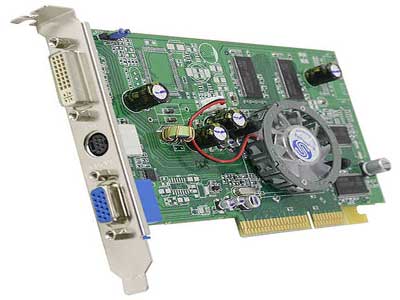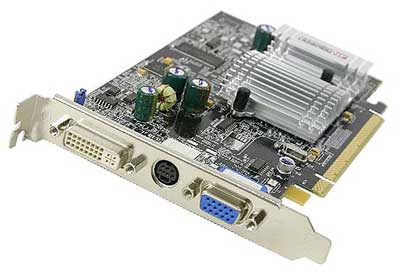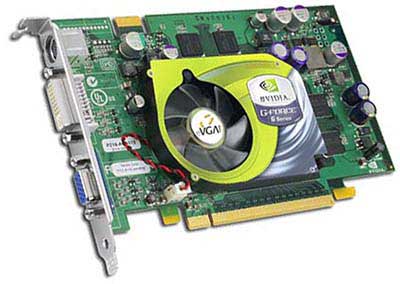Buyer's Guide - Mid-Range, October 2004
by Jarred Walton on October 21, 2004 11:00 AM EST- Posted in
- Guides
Graphics Recommendations
The only typical applications that actually require a decent graphics card are games, but depending on how you plan to use the system, adding a little more power to the graphics subsystem may not be a bad idea. We listed an integrated graphics motherboard as an option for a base Intel system, and that will save you a little money. For the AGP models, a basic Radeon or GeForce will get you by. One of the advantages of purchasing an add-in card is that even the basic models support two displays. This is definitely an advantage for software development and content creation work, where having dozens of windows open at a time is par for the course.Those who are interested in more serious work, like 3D modeling and rendering, might want to look into professional 3D graphics cards, although moderate consumer graphics cards will be sufficient for less serious work. Those looking for an all-around system will also want more than just a basic graphics card. With that said, let's get on to the recommendations.

AGP Recommendation: Sapphire Radeon 9600 Pro 128MB
Price: $108 Shipped (OEM)
At just over $100, the 9600 Pro offers tremendous value. Casual gamers will have more than enough performance for most games, while those interested in content creation or software development get the proven reliability and performance of ATI's drivers. TV Out is also included, for those who might be looking for a Home Theater PC. While it might seem like overkill for anyone who doesn't use any form of 3D graphics, it is hard to recommend anything less than a DirectX 9.0 capable graphics card for any system costing over $1000. Remember that Windows Longhorn - assuming it ships anytime soon - is going to require DX9 support as the bare minimum in order to run. The one option that isn't available for this price is dual DVI output, so those looking at running dual LCD displays might want to find a model that has two DVI ports. While the performance is lower, HIS makes a dual DVI 9600 card that might interest some of you. Downgrading to a stock 9600 or even a 9600SE is also an option if you are sure you don't need the added performance of the 9600 Pro.

Basic PCIe Recommendation: Sapphire Radeon X300 128MB
Price: $85 Shipped (OEM)
PCI Express graphics cards tend to carry a slight price premium, and the X300 is actually comparable to the 9600. The X600 Pro matches the clock speeds of the 9600 Pro, but it costs a little more. For basic computing tasks other than gaming, they will both perform acceptably, so here we go with the slightly cheaper X300. Unfortunately - or fortunately if you're looking for an excuse to upgrade - those looking for dual DVI ports will need to buy a 6600GT card for the time being; specifically, the XFX is one card that includes that option. There are no other PCI Express graphics cards with two DVI ports other than the ultra-expensive X800 XT and Quadro FX1300, which really aren't an option for this price range.

PCIe Alternative: eVGA 6600GT 128MB
Price: $207 Shipped (Retail)
Here, PCI Express has a slight advantage in the price/performance category. The 6600GT includes 8 pixel pipelines, and with a core clock of 500 MHz, it outperforms any AGP card in the same price bracket. ATI's X700 Pro is also available at about the same price and it is similar in features, but comes with 256 MB of GDDR3. The X700XT with 128 MB of RAM and faster clock speeds is also due to show up in retail any time now, but we have not been able to find it there yet. This is really a gaming option, but we would feel remiss if we didn't at least mention it, as the 6600GT is one of the best price/performance graphics cards currently available.
For AGP systems that will be used for moderate amounts of gaming, the only comparable card right now is the 9800 Pro. It's a bit slower in most games and lacks support for SM3.0 but it performs acceptably. The GeForce 6800 is also an option that is slightly faster than the 6600GT and costs a bit more.










54 Comments
View All Comments
filterxg - Tuesday, November 2, 2004 - link
I think this type of article is great. I may be in the market in the next 2 months and am reading up. Considering waiting until 64-bit XP comes out. But my Athlon 850 is on its last legs, and no news from Microsoft is bad news for me.JarredWalton - Tuesday, November 2, 2004 - link
I know what you mean on the tech support side. Problem is, even if I told my mom or whomever to buy a Dell, I *know* that I would end up doing the support. My mom wouldn't even know what the hell to say to a Dell support person. I laugh just thinking about it. (Yeah, I built her a PC so that she can get email. Now I get questions asking me why Juno doesn't work and sometimes crashes. Ugh.)Also, for those that were wondering about the choice of DVD+R, you can now see where I got the information for the NEC 3500A:
http://www.anandtech.com/storage/showdoc.aspx?i=22...
I had the Pioneer in originally, and Kris let me know in advance that the NEC was slightly preferred. Both are good drives, though, so it's not a decisive win in all areas. (Not like anyone is going to see the comment other than HH, but oh well.)
hh - Monday, November 1, 2004 - link
> HH - Hobbyist DIY vs. "regular" DIY? I don't> even know that I gave it that much thought.
It is merely something to consider.
>I actually find it fun to build new PCs.
Glad you enjoy it. My interest is to get on with it to using the PC, not the screwdriver-turning.
I'll still DIY if the cost savings potential is big enough to motivate...the problem is that that bar gets raised progressively higher as I have less free time. If the OEM price premium is less than 10-20%, I'll pay it in a heartbeat.
(Of course, this assumes ojbectively equal products, so we're back to system benchmarks questions).
>Having done plenty of support at companies that
>use Dell and other large OEM PCs, I wouldn't
>recommend them to an individual.
I know and undertand the frustration here. But we've already agreed that DIY's are not for the non-savvy PC user; my mother-in-law is a prime example...she's on dialup but can't figure out how to have the antivirus app do its updates.
>For businesses that can pay the extra $$$ for
>the support contracts, sure, go for it, but
>individual users? I just don't see OEMs as
>providing enough *quality* support to warrant
>my recommendation. YMMV.
The only thing worse than the OEM's are the "Armchair Expert" helpers. Based on their "expert" advice, Mom-in-Law just paid for a hard drive replacement to fix a spyware infection problem.
The frustrating part is that we both know that this failure mode is going to occur again. I'm tempted to convert her over to Apple to stop it, but that would cause a Family fight, especially since Sis-in-law doesn't want to have to admit that the spyware infections are being caused by her kids surfing on their Grandma's PC...
Pass me that bottle of Scotch, would you? :-)
-hh
JarredWalton - Friday, October 29, 2004 - link
HH - Hobbyist DIY vs. "regular" DIY? I don't even know that I gave it that much thought. I know that I personally would never go out and buy an OEM desktop system, but I'm probably far from your typical PC user. I actually find it fun to build new PCs. Having done plenty of support at companies that use Dell and other large OEM PCs, I wouldn't recommend them to an individual. For businesses that can pay the extra $$$ for the support contracts, sure, go for it, but individual users? I just don't see OEMs as providing enough *quality* support to warrant my recommendation. YMMV.BBurk: To get a "quiet" setup, the Antec 3700BQE is a great start. If you really want quiet, add in a Zalman CNPS7000A/B heatsink and fan, as it is again nearly silent. You could replace the PSU with one of the fanless Thermaltake or Antec models - only 350W, but that should suffice, I think. Both Seagate and Samsung make near-silent hard drives, although the latest WD, Maxtor and Hitachi really aren't any worse, I don't think. I just say avoid WD Caviar with non-FDB bearings. Also, if possible, look for a motherboard that doen't use a fan on the northbridge, and if you don't need the graphics power, get a graphics card that uses only a heatsink as well. That would make a system virtually silent, at the cost of some performance (especially on the graphics card).
hh - Thursday, October 28, 2004 - link
#48/JarredWalton>Actually, HH, shipping *was* included...
Sorry, I missed that detail.
> What you don't get are several upgrades that
> most hobbyists would like.
On the contrary. What you apparently missed is that I had very explictly and specifically differentiated DIY'er types upfront and was not talking about the classical hobbiest.
Instead, I was talking about DIY'ers who do it because of the cost savings, and who generally doesn't care a lick about possible future upgrades: they care about are today vs. OEM and usually not much else.
> The case/PSU and motherboard are proprietary
> designs, so if one of those items fails after
> the warranty expires...
A valid if generally negligible risk, due to the classical "Bathtub" shaped reliability curve for electronics. Yes, some OEM's have real garbage, but let's also not overhype this objective risk.
> I realize not everyone can build their own PC,
> but most Anandtech readers are more than
> capable of doing so.
Anotehr truism, but simply not a particularly relevant point to my arguement.
> That's who we target with our Guides.
Are you targeting hobbiest DIY'ers, or all DIY'ers?
I'd say you're really only doing the former.
FWIW, it appears to me that you've essentially assumed that just because one can DIY that one will always DIY. That can be a bad assumption. IMO, this is possibly why some posters asked about benchmark tests, and why I suggested also including OEM systems in such a comparison too, as I was following the classical business case of a "Make or Buy" decision.
Please understand that I'm not Anti-DIY or Pro-OEM: I'm agnostic. Our differences are likely because my criteria for when my time investment in a DIY is justified is different than what yours is, and the net result is that I don't automatically reject all OEM's without even a glance.
-hh
BBurk - Thursday, October 28, 2004 - link
What reccomendations of changes would you make for a very quiet/silent system? thanksJarredWalton - Monday, October 25, 2004 - link
Actually, HH, shipping *was* included (and added about $50 to the total). That's shipping to the continental US, of course, so if you live somewhere else it would be different.I put together a Gateway system with a P4 530 and X300SE, 1GB of RAM, 19" monitor, and 2.1 speakers. Including OS and MS Works (which OEM costs $71) we get a total price - shipped with 1 year warranty - of $1364. Adding Works and XP Home to the P4 system in this guide costs $1385. For all intents and purposes, then, it's a tie in price.
If you only want a basic system, then, Gateway would be fine. What you don't get are several upgrades that most hobbyists would like. Better graphics, better speakers, better monitor, better case, better motherboard, etc. Gateway will give decent parts in each category, but the emphasis will be on cutting costs.
The case/PSU and motherboard are proprietary designs, so if one of those items fails after the warranty expires, your only choice is to either buy an expensive replacement from Gateway, or else buy a new case, PSU, and motherboard. Proprietary designs are a really bad thing, people. I would spend more money at a local computer shop for a "generic" PC rather than buy a Dell or Gateway or other OEM.
My rate for building a PC and installing the OS is $100, which is pretty typical. That amounts to about $25 an hour. If I wanted to cut $100 out of the system cost by going with cheaper components in every area, I could certainly do so, but then reliability is compromised.
I realize not everyone can build their own PC, but most Anandtech readers are more than capable of doing so. That's who we target with our Guides. Some people think that OEM systems are more reliable due to their warranties and such, but that's not the case in my experience. I would say 90% of the PCs people ask me to help fix are OEM designs. Maybe that's because the non-OEM systems are built by people that can manage on their own, or maybe it's because the parts don't fail as often. I know what I think, but you're entitled to your opinion.
The only caveat is that I won't build a PC for someone that knows nothing about computers. I can't provide 24/7 tech support. OEMs do give you that, although the quality of the provided support is questionable. :)
hh - Monday, October 25, 2004 - link
#40/Jarred Walton> #34 brings up an interesting argument.
Thanks for the compliment.
> If you actually went out and bought the same hardware that goes into [an OEM], the price would be a lot lower than what is listed here...The price of OEM systems appears attractive, but in the end you get what you pay for.
I agree, but offer an alternative perspective. In my view, the're two very common shortcomings in the DIY-vs-OEM arguements.
The first is trying to decide/define equivalency. Its too easy to get lost down in the weeds (specific components, etc) and essentially ignore system performance.
For example, I can put together a "kinda looks equivalent" Gateway for $1319 or buy the one DIY and add the OS for $1304 - - - a whopping $15 cost savings for skipping the OEM's assembly, warranty and copy of MS-Works software. The catch here is that the OEM's probably doesn't benchmark at 100% of the DIY, but how close is good enough? 99%? 95%? 90%? 80%?
There is no simple, cut and dry answer to this question: its a personal opinion based on what significance rankings and (cash) value you want to put on the differences between the two contenders.
The second shortcoming is in how we choose to count our costs. For example, this article ignored shipping costs, probably because we all know that they'll be different for all of us.
But in the similar fashion, we also commonly ignore how much our labor is worth when we do a DIY assembly. And we can argue that we do this because we'll all put different values on how much our time is worth.
But the real bottom line is that our free time is never worth nothing, despite the fact that we invariably choose to ignore it in the cost of doing a DIY PC build, which results in faulty accounting for how much we're really saving.
FWIW, if anyone really wants to claim that their free time really is worth zero dollars, I have a lot of chores for you to come over and do at my house...heck, I'll even pay a whole $5/hour :-) Funny thing is that I don't ever get any takers at this hourly rate...it seems that everyone knows that their time is worth more than this, and yet never includes it in their DIY budget. Hmmm. :-)
-hh
TrogdorJW - Monday, October 25, 2004 - link
#45: XP Home will actually work with up to two CPUs, I believe. Someone can correct me if I'm wrong. Anyway, I *think* that MS actually recognizes HyperThreading at a low level and only counts it as one CPU even though it show up as two. Anyone out there able to confirm that for sure?slashbinslashbash - Sunday, October 24, 2004 - link
2 things:1) XP Home still isn't SMP-enabled, right? Therefore shouldn't the recommendation be XP Pro if you get an Intel (Hyperthreaded) setup?
2) Gamers (and others griping about the 9600Pro in this guide) should look to the Overclocking Buyer's Guide released about a month ago. That guide included a 6800GT in a system costing $1113 (without monitor/keyboard/mouse/etc). Downgrading to a 9800Pro would leave the system comparably priced to the systems in this Midrange guide. Also, the case/PSU in that guide was pretty expensive as well.